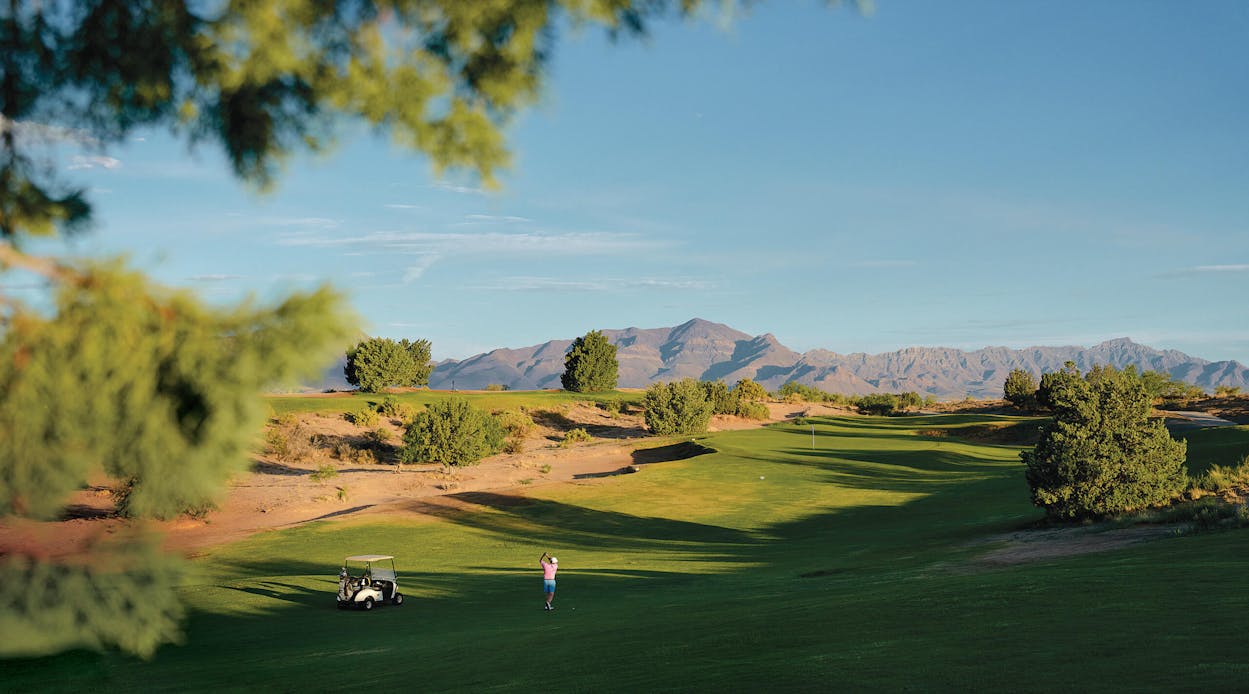You don’t need to belong to a country club, or even have especially deep pockets, to enjoy high-quality golf. Here we are blessed with plentiful daily-fee and municipal courses. According to recent National Golf Foundation statistics, Texas ranks fifth in the U.S.—behind only California, Florida, Michigan, and New York—in number of public courses, with some six hundred tracks across the state. That’s roughly the same as our number of Dairy Queens.
For this guide, seven staffers and freelancers, including one who is new to the game, collectively traveled thousands of miles to all corners of the state, putting in the hard work to come up with our list of eighteen (seemed like a good number) of Texas’s greatest public golf courses. Note that the result of those efforts is not intended to be an exhaustive top-to-bottom ranking. This is a collection of courses that we found to be unique, often distinctively representative of the environment in which they are found—true desert golf in El Paso and classic Hill Country golf, for instance. Each had to be a great bang for the buck (prices listed are for eighteen-hole rounds and range from senior weekday up to prime weekend rates). Perhaps most important, they’re accessible to all, no matter the skill level, whether you’re a scratch golfer, a weekend warrior, or an eager beginner.
We hope the following inspires you to get out and tee it up during what we regard as the best time of year to play in Texas. The weather is typically pleasant in the fall, and the fairways and greens are lush. What’s more, many of your neighbors will be watching football, and others will be hiking, fishing, and hunting on the weekends, often leaving your favorite course, or one you’d like to try, gloriously uncrowded! —David Courtney
Browse by region:
- Houston and East Texas
- West Texas and the Panhandle
- San Antonio and South Texas
- Austin and the Hill Country
- North Texas
Houston and East Texas
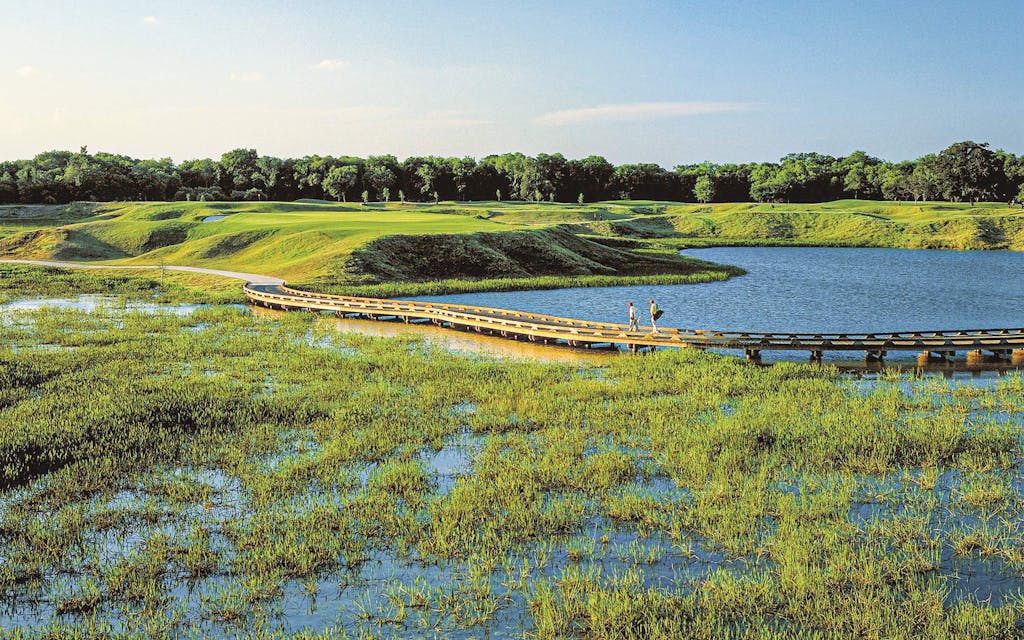
BlackHorse
Cypress
This 36-hole complex is wedged inside the BlackHorse Ranch community, about thirty miles northwest of downtown Houston. The spacious homes that occasionally appear along the fairways give the place a country-club feel, as do the steep greens fees for prime tee times. But you get your money’s worth at this beautiful course, designed by Jim Hardy and Peter Jacobsen, that’s an homage to the region’s wetlands. Even better, the choice of six tee boxes makes it accessible to even the humblest duffer.
Start with the North Course, which opens and closes with broad, rippling fairways that are forgiving, but only up to a point: the long, wispy rough can devour wayward balls.
The South Course makes up for its shorter length—7,191 yards from the tips compared with the North’s 7,301—with a more demanding layout. Seven holes include water features running along most or all of their respective fairways, and a winding creek occasionally comes into play. The sixteenth and seventeenth holes are especially memorable. The former, a short par 4, dares big hitters to drive over a beautiful marsh, and the following par 3 is effectively an island—a wooden bridge just above the waterline takes you from tee box to green. The spectacular wetland landscape and resident waterfowl provide consolation for any splashed shots.
To top it off, there’s a well-stocked pro shop, and Roper’s Grill offers comfortable indoor and outdoor seating where you can enjoy the Big Jake cheeseburger (named after course designer Jacobsen) or a variety of sandwiches and generously portioned salads, along with beer, cocktails, and wine. —Josh Alvarez
12205 Fry Rd, 281-304-1747; greens fees $59–$160; blackhorsegolfclub.com
Pine Dunes Resort
Frankston
This magnificent (and easily walkable) course burst onto the Texas golf scene two decades ago, when Jay Morrish and his son, Carter, engineered eighteen holes that evoke the Sandhills region of North Carolina. Those who’ve played there, especially at Pinehurst, will feel a certain déjà vu amid the towering pines, flawlessly true greens, and firm, sandy turf. If you know, you know.
Located some thirty miles southwest of Tyler, Pine Dunes might be the most remote course in East Texas, tucked behind dense forests with only the occasional small residence visible along the narrow highways leading to it. But that’s part of the allure. The resort seems to occupy its own universe of constellation-filled skies and pure silence. The grounds have a distinct mom-and-pop vibe, with spartan but entirely sufficient accommodations along the eighteenth hole. There, overnighters can relax around the firepit, tend to the communal grill, and swap admiring reflections about the course. The ambience—the embers, the smoke, the chorus of nature sounds, and the smothering darkness of a night far away from any city—enriches the sense of community and fellowship.
The course wanders through the trees and sand as if staking out its own wilderness expedition. The theme is established on the first hole, a 391-yard par 4 that bends right to left around pines too tall to carry. Holes move in every direction at Pine Dunes, making wind a complicating factor. A confident shot shaper will do well here. The course offers holes that are short (a tempting 344-yard par 4 at number fifteen) and long (the par 5 at number eleven stretches 605 yards from the back tees over a waste area), straight and meandering, uphill and down, sidehill and level. The round culminates with a par 5 that angles 90 degrees after the drive. The perfect tee shot misses the pines on the left and the marsh and sand on the right. —Kevin Robbins
159 Private Rd 7019, 903-876-4336; greens fees $79–$139; pinedunes.com
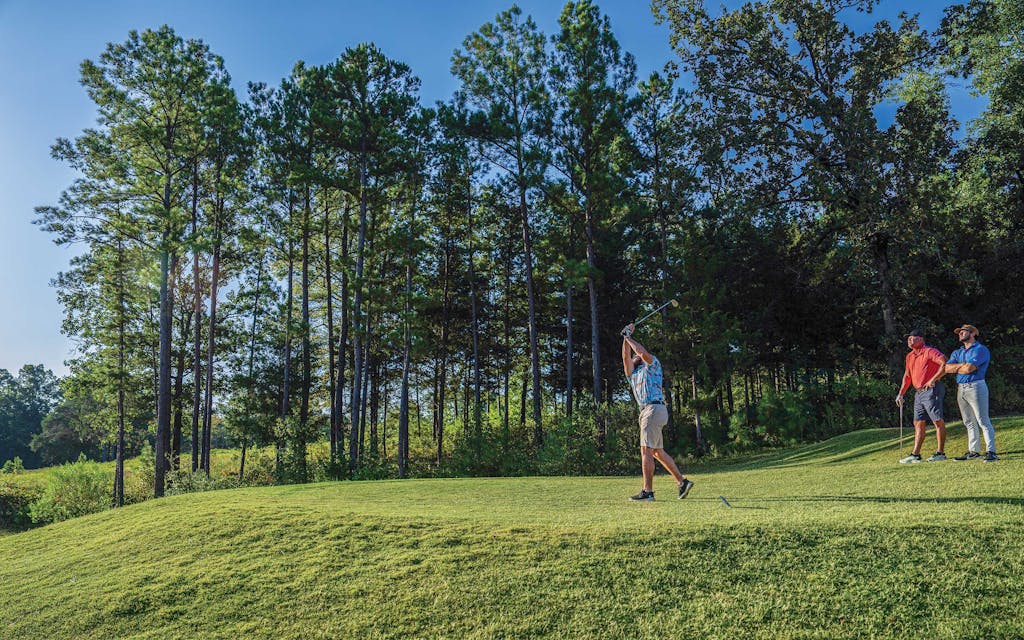
Tempest
Gladewater
Shaded by longleaf and loblolly pines, the terrain of the Piney Woods of East Texas provides a dizzying setting for golf. The angles, chutes, shadows, and slopes of this Jeffrey Brauer creation, fifteen miles west of Longview, make every hole look like a photograph in a coffee-table book. Playing here requires serious artistry too.
Big and bold, the course opened in 2018 and measures 7,229 yards. Six of its holes occupy what used to be the decrepit Southern Hills Golf Club. The emphatic shaping of Tempest’s dramatic mounds, saddleback corridors, and spectacular greens—number sixteen resembles a heaving sea—makes it a modern, spacious American golf course that could stage a professional tournament with little additional preparation. The par-5 sixth, a mesmerizing downhill hole that falls to the lowest spot on the property, is tantalizingly reachable in two—if you can escape the bunkers dotting the journey to the green.
Tempest is remote for big-city folk but well worth the drive. Lodging is available for the weekender, who might elect to play the white tees (6,051 yards) on a crisp morning and the all-you-want blues (6,748) in the afternoon. A well-appointed clubhouse includes Neptune’s Grille, with twelve plates on the breakfast menu and a full stable of appetizers, salads, sandwiches, and wraps for lunch. —Kevin Robbins
568 East Wilkins Rd. 903-984-5335; greens fees $52–$89; tempestgolfclub.com
Gus Wortham
Houston
For years, Wortham, the oldest eighteen-hole course in the city, was an afterthought. The clubhouse was small and the roof leaked. The driving range was scarcely longer than a par-3 hole. Distinguishing where the fairways ended and the roughs began was a matter of epistemological debate. The greens were at once boring and unreadable. Wortham, located in the city’s East End, was the proverbial kid from the wrong side of the tracks—a railroad busy with freight trains runs across its northern edge.
In 2014 the course came close to being turned into the city’s botanical garden. Luckily, after concerted pushback from locals, the Houston City Council voted unanimously to reinvest in Wortham, and another muni, Glenbrook, was chosen for the garden, which opened in 2020.
Thanks to some TLC over the past six years, Wortham boasts a freshly rebuilt clubhouse, an all-grass driving range, resplendent fairways, and attractive, constantly beguiling greens. And golfers have noticed: in 2016, before renovations began, the course was averaging just fewer than 17,000 rounds played per year; since reopening in October 2018, it’s been averaging more than 50,000 a year, according to the Houston Golf Association, which manages the course.
Still, Wortham hasn’t lost its edginess. It’s at times nerve-wracking, and that tone is set almost from the get-go. The second through fourth holes, two consecutive par 5s and a long par 4, run alongside busy thoroughfares. A badly sliced tee shot (for right-handers) that might be salvageable elsewhere is liable to find a new home in the bed of a pickup. Beginners who aren’t yet confident with the driver can still mark a decent score if they opt for a shorter club.
After the gauntlet of those three holes, the cacophonous urban surroundings recede quickly, and it becomes clear why this parkland course was the city’s first choice for the botanical garden. Still, the verdant peacefulness doesn’t translate into gentler challenges. None of the holes are gimmes, yet we hackers are given plenty of chances at glory in part because it’s a compact course: just 6,388 yards from the tips. Eight of the eleven par 4s measure fewer than four hundred yards.
The track may be short, but it’s beautiful, and it has teeth, much like its unofficial mascot. —Josh Alvarez
7000 Capitol, 713-928-4260; greens fees $18–$55; hga.org/gus-wortham

Flora, Fauna, Fuhgetaboutit!
Houston’s Gus Wortham might be the Texas muni with the wildest resident: an eight-foot alligator who can sometimes be found sunning himself along Brays Bayou, just off the seventh hole (best not to think about it too much as you’re teeing up). His name is, no surprise, Gus, and he’s the landlord here, as the staff are fond of saying.
Memorial Park
Houston
Bayou City golfers should count themselves lucky, if not downright spoiled. It’s rare to have a municipal course that’s fun, meticulously maintained, conveniently located—fewer than six miles west of downtown—and affordable. (Non-Houston residents, by comparison, must surrender a big chunk of their wallets to play.) Don’t bother with the $17 cart fee; this course offers an easy, enjoyable walk, and regular rainfall often means you would have to confine the cart to the paths, which means you’ll end up walking about as far anyways.
Designer Tom Doak renovated the course, which reopened in 2019, with some input from five-time major-tournament winner Brooks Koepka. It’s now one of two municipally owned courses on the PGA Tour and host of the Houston Open. Mere mortals need not fear: while playing from the tips stretches the course to a whopping 7,432 yards, one tee box down reduces it to a manageable 6,553 yards, making it appealing to both scratch golfers and hacks.
Those who fear the sand will rejoice at seeing fewer than twenty bunkers during the round, but in exchange players must carefully navigate grass hollows, deep ravines, and thick Bermuda grass that clutches balls when they miss the fairway. Make use of the double-decker driving range to get your iron distances dialed in, because the greens can be unkind. A prime example is the par-3 number seven, which slopes right to left toward a bunker and front to back toward a ravine. A precise, soft shot to the front allows the ball to release and stop before trouble. After the round, head over to the Becks Prime, located on-site, and treat yourself to the Bill’s Burger or the bacon cheeseburger, which this magazine once ranked a top-ten burger in the state. —Josh Alvarez
1001 E Memorial Loop Dr, 832-395-7653; greens fees $15–$157; houstonmunigolf.com
West Texas and the Panhandle
Ross Rogers
Amarillo
Like so many Panhandle towns in the thirties, Amarillo was subjected to the double whammy of economic depression and devastating dust storms. But the seat of Potter County was also the region’s hub for federal New Deal programs, which provided funds for the construction of public projects in the city, including sidewalks—you can still see rectangular stamps imprinted with “Works Progress Administration” on curbs along Sixth Street—and, in 1939, its first municipal golf course, which was named after the mayor at the time, Ross D. Rogers. This golf facility, which opened in 1940 as an 18-holer, was expanded to 27 holes in 1959 and then to two 18-hole courses in 1978. The ensuing decades saw major renovations to both courses, now named WildHorse and Mustang, and today players enjoy the fruits of those investments.
Laid out over gently rolling terrain, WildHorse is marked by fairways that are lined with tall, stately elm trees. Mustang features far fewer trees and is much more open, but areas of thick grass await golfers whose balls stray from the fairways. Neither course provides much in the way of water hazards, though both have enough bunkering to hold your attention.
Each course offers five sets of tees, with Mustang’s length ranging from 5,321 to 7,227 yards and WildHorse’s from 5,123 to 6,926. Of the two, the slightly longer Mustang, which features several blind tee shots and more exposure to the Panhandle winds, probably offers the greater challenge. The real stars of both courses are the well-kept and gently undulating bent-grass greens. A good day with the flat stick will always be rewarded. —David Courtney
722 NW 24th Ave, 806-378-3086; greens fees $23–$47; playgolfamarillo/ross-rogers

Butterfield Trail
El Paso
This spectacular desert track set in the scenic foothills of the Franklin Mountains takes its name from the historic Butterfield Overland Mail stagecoach route, which ran through Paso del Norte on its way to San Francisco from 1858 to 1861. Designed by famed architect Tom Fazio, the course was built and operated by El Paso International Airport, which owns the land (the airport itself is nearby, but air traffic when I visited wasn’t objectionable). Butterfield almost immediately started landing on annual lists of the country’s best public golf courses, thanks to its picturesque layout, immaculate maintenance, and well-appointed clubhouse and practice facilities.
Yet Butterfield, which opened in 2007, just prior to the Great Recession, was financially snakebit from the start, and when the city faced a massive budget shortfall in the early months of the COVID-19 pandemic, it shuttered the course, in May 2020. Thankfully, just three months later, it reopened after the city handed operations to private management, and it quickly returned to splendor.
The Fazio signature of hiding cart paths from the player’s view allows golfers to immerse themselves wholly (hopefully not too wholly) in the adventure of a desert course. Over its 7,307 yards (there are five sets of tees), look for gentle elevation changes across the rolling terrain, plenty of sand and thorny trouble off the fairway, and a few water holes. And note the surprisingly affordable prices too. —David Courtney
1858 Cottonwoods, 915-772-1038; greens fees $25–$49.95; butterfieldtrailgolf.com

Not Pro Tip
Are you chunking, skulling, hooking, slicing, or entirely whiffing the ball? You need some swing oil, and there’s no stronger lubricant than some good ol’ Texas Tea: one-half ounce each gin, vodka, tequila, rum, triple sec, and whiskey, plus a splash of cola and sour mix (or lemon juice). If that doesn’t loosen you up, it’ll at the very least help you forget your score.
Painted Dunes
El Paso
A standout in the Texas golf scene since its opening, in 1991, this 27-hole facility (a third nine, the North Course, debuted in 1999) is, along with nearby Butterfield Trail (see above), one of the state’s few true desert courses. The layout also makes great use of the nearby Franklin Mountains, framing many tee shots with some of the most picturesque views of any course in the state.
Although Painted Dunes is positioned in the foothills of those mountains, the links-style design doesn’t feature much in the way of elevation change. The course isn’t particularly long, either, measuring 6,900-plus yards from the tips. (There are four sets of tees, with front markers that bring the yardage down to just over 5,600.) But there are numerous pot bunkers and green complexes that demand careful placement, and plenty of Chihuahuan Desert to keep even the skilled golfer constantly balancing risk with reward.
Whether one chooses the original East-West eighteen or a different combination involving the North course, Painted Dunes offers a challenging, fun, scenic, and pleasantly affordable desert experience. —David Courtney
12000 McCombs, 915-821-2122; greens fees $27.50–$59; painteddunes.com
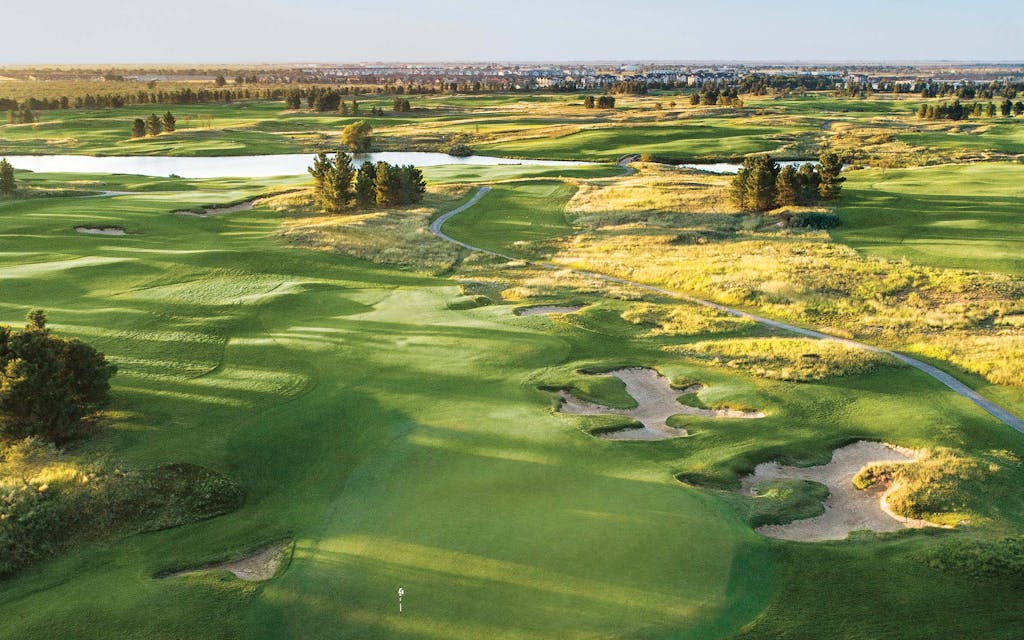
The Rawls Course
Lubbock
If a mark of an outstanding golf course is its relationship and fidelity to its environment, the Rawls Course, on the Llano Estacado, just might be the most Texan course in the state. Designed by Tom Doak and opened in 2003, the acclaimed home course of the Texas Tech golf teams confronts players with two prominent features of northwest Texas: level land and a gusting wind.
Doak rearranged more than 1.3 million cubic yards of Lubbock topsoil to dimple the space with endless bumps and ripples. Tall, wispy grasses thrive in the rough between generous fairways, helping to define them amid the flat landscape. The result is a vexing and invigorating golf experience reminiscent of that provided by the seaside links of Scotland. The wind that typically scrapes the High Plains can ratchet up the difficulty at Rawls. Low, running shots are the ticket here. The few Afghan pines on the course provide little shade or protection from the wind. There are just enough of them to serve as shot targets. Use them prudently to avoid the course’s rough and its 97 craggy bunkers.
The fourteenth hole, a 506-yard par 4, features a yawning fairway with a deep bunker standing sentry inside the left-to-right bend in the landing zone for tee shots. The approach plays slightly uphill, to the most compelling green on Rawls (which is saying something, because they’re all inspiring). The front of the putting surface falls left into a hollow. A modest saddleback in the middle rises to a narrow plateau at the back, with two gaping bunkers on the left and a generous bailout area on the right. Setting up a birdie putt of any length is an achievement. And for most golfers, so is a bogey. —Kevin Robbins
3720 Fourth, 806-742-4653; greens fees based on demand; therawlscourse.com
San Antonio and South Texas
Brackenridge Park
San Antonio
Brack, as it’s lovingly known to San Antonians, has been listed among the best public courses in the U.S., and for good reason. It’s a treasure, both for its rich history and for the challenge it offers, at an attractive price. Host of the Texas Open for almost four decades, the course was designed by the famed architect A. W. Tillinghast, whose résumé includes such U.S. Open venues as Baltusrol and Winged Foot. Located just two miles north of the Alamo, Brackenridge opened in 1916 in a sparsely inhabited area where, according to a plaque near the clubhouse, construction workers were menaced by “wolves, bears and other critters then native to the area.”
Measuring just 6,200 yards, the course plays longer, thanks to strategic placement of bunkers, trees, doglegs, ponds, and creeks. Many of the greens are narrow, elevated, and guarded by traps, including at the signature eighth, a lovely and wicked 188-yard par 3. The greens sometimes suffer from extensive traffic, especially during dry periods.
The pro shop offers a full range of ammo and armor, plus sandwiches and beer. Golfers can warm up at the Polo Field Golf Center’s driving range just a mile to the north. Many locals buy a membership that offers discounts on the city’s eight courses, including Brack. —Dan Goodgame
2315 Avenue B, 210-226-5612; greens fees $47–$82; alamocitygolftrail.com/brackenridge-park-golf-course
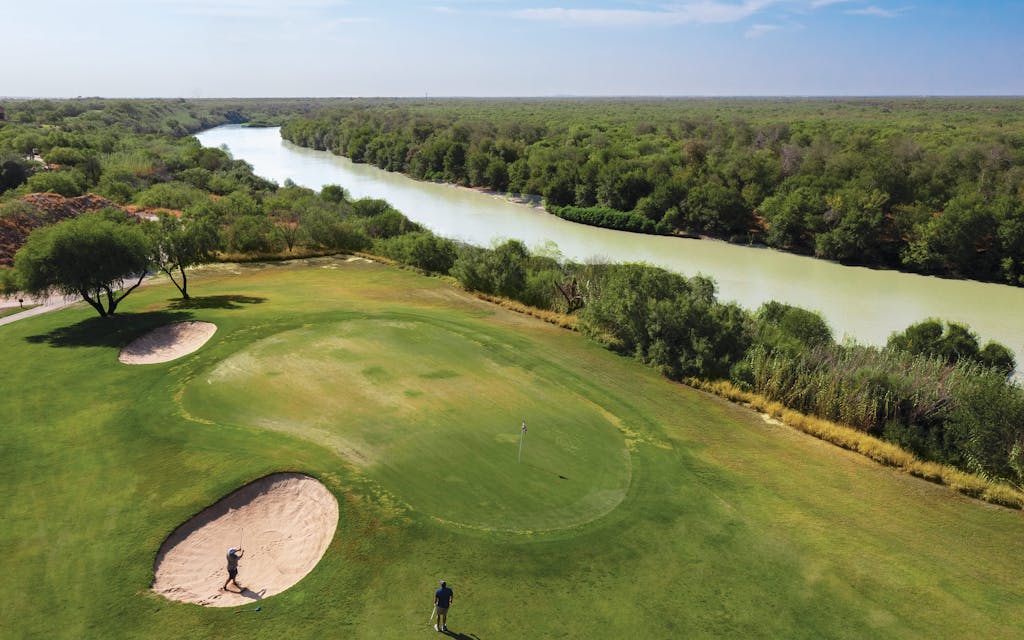
Max A. Mandel
Laredo
The Max, as locals refer to it, opened in 2012 and immediately earned lots of attention, for its unlikely beauty, for how it was realized, and for its affordability. The City of Laredo secured the typically high-dollar design services of Robert Trent Jones II at a discount when a sagging economy had leading golf course architects hustling for work. Jones coaxed eighteen distinct and handsome holes from 280 acres of donated wind-scraped scrub-land northwest of the city and high above the Rio Grande. And you could play them for the cost of a dozen premium golf balls.
The wide, welcoming routing moves through copses of mesquite trees, with views of the green river and Mexico beyond. Jones placed an emphasis on playability over punishment for wayward shots. There’s only one water feature in play, and few forced carries. But the experience feels like an adventure in the desert, from the rollicking slopes of the green at the short par-3 fifteenth to the sheer spectacle of the par-4 eighteenth, which spans 450 yards from the back tee over an arroyo on the approach. Swallow hard before that shot over the wash. Snap a picture too.
Then take a chair in the cool climes of the Las Islitas Café, which serves eleven kinds of breakfast tacos and other regional provisions. After a late afternoon round, go upstairs, to the south-facing second-floor patio, which is illuminated at dusk by string lights. You’ll swear you can see all the way to Monterrey. —Kevin Robbins
2700 FM 1472; 956-726-2000; greens fees $38–$55; themaxlaredo.com
Austin and the Hill Country
Roy Kizer
Austin
Austinites who pine for simpler times in the Capital City will delight in this muni seven miles southeast of downtown. Opened in 1994, Roy Kizer (which takes its name from a devoted local course superintendent) still has the unpretentious flavor of that smaller-town era. As a first-time player harboring a few preconceptions about golf’s stuffiness, my nerves were immediately assuaged by the sight of folks at the driving range in colorful shorts and Hawaiian shirts and by the hip-hop and reggaeton wafting from carts whizzing by. While my companions and I grabbed tall boys at the clubhouse, I found myself thinking that if this was golf, there were worse ways to spend a Sunday.
But it’s not just the attitude here that makes the par-71 course appropriate for all skill levels. Architect Randy Russell, who also worked on the design of the University of Texas Golf Club, once said he wanted Kizer to “give pleasure to the greatest number of players without respect to their capabilities.” The impeccably maintained, links-style course achieves just that with its spacious greens and undulating fairways. If your tee shot misses the short stuff (as mine might have more than once), the layout forgives, mostly: it’s easy to find and play your ball, but you’ll have to learn how to chip at odd angles and play from steep knolls.
That’s not to suggest experienced linksters won’t find Kizer stimulating. Five sets of tees stretch it from the 5,018 yards I played to 6,819 at the tips. And while the course, which abuts McKinney Falls State Park, is mercifully short on sand, water hazards are a constant thanks to its 22 acres of wetlands, which double as a habitat for migratory birds. The trade-off for a few drowned balls comes as you round the eighth hole, when the landscape opens up and you find yourself suddenly alone among the egrets and herons and cormorants bathing in the glassy marsh. In that moment, it’s hard to think of better ways to spend a Sunday. —Alicia Maria Meier
5400 Jimmy Clay Dr, 512-974-4653; greens fees $29–$62; austintexas.gov/department/roy-kizer-course

Vaaler Creek
Blanco
The Hill Country, with its gentle elevation changes, abundant live oak, cedar, and mesquite trees, and meandering creeks, provides an ideal landscape for golf. This eighteen-holer tucked inside the Blanco luxury community Rockin’ J Ranch, about halfway between Austin and San Antonio, makes outstanding use of the region’s natural advantages. The rates here are steep compared with some public tracks in the area, but in exchange you get a gorgeous course, plus some touches of luxury. The golf cart, for example, comes equipped with a touchscreen range finder, and a good thing too, because you’ll need it regardless of whether you play from the tips or, like me, the forward tees.
Vaaler isn’t long, at 6,801 yards from the tips. Here finesse, not power, wins the day. The easiest way to find trouble is to overshoot: nearly every fairway is doglegged, some sharply—you often might be better off leaving the driver in the bag lest you sail over the fairway and find yourself communing with one of the many deer that roam among the trees. The MiniVerde greens are roomy, but disaster is almost always guaranteed if you pick too long a club on the approach. I counted only sixteen bunkers, but water features come into play eight times, most dramatically on the par-4 eighteenth, where at minimum one hundred yards of liquid separate fairway from green.
The forward tees are for the most part fairly situated, except for the par-4 fourteenth, where an oak tree that was of little concern to the men in my group towered directly in front of me as if it were Victor Wembanyama preparing to swat my ball out of the air. But outside of that, I felt challenged but not frustrated. My final score had one more digit than I would’ve liked, but any regrets soon dissipated as I looked out from the clubhouse’s deck, shaded by ancient oaks, sipping a mimosa and admiring the sunset. —Lauren Castro
228 Jeff Vaughn; 830-833-0706; greens fees $65–$90; vaalercreekgolfclub.com

Flash of Inspiration
During the 1975 Western Open, Dallas native and pro golfer Lee Trevino was struck by lightning. He suffered some nasty burns but was soon back to playing. As Trevino tells it, he brought heaven’s wrath upon himself because a week earlier, at the U.S. Open, when an official told him to take shelter during a lightning delay, Trevino refused and quipped, “Don’t worry about it. I’ll take a one-iron out and just hold it up, because not even God can hit a one-iron.”
The Buckhorn
Comfort
You might think that nothing visible from Interstate 10 could qualify as a hidden gem. But in the case of the Buckhorn, located in the lovely Hill Country town of Comfort, 90 miles southwest of downtown Austin, you’d be mistaken. I had driven past the course dozens of times before I played it, and what I could see through the windshield didn’t look all that impressive. The opening and closing holes for each nine looked like those on the many public courses that have been carved out of pastures, with just a few trees separating the parallel fairways. The clubhouse, viewed at 70 miles per hour, seemed small and plain.
Luckily, one of my golf buddies, who often plays Buckhorn, was able to set me straight. “You’re going to love it,” he said. He was right. The opening fairway that appeared so boring from the freeway? Turns out it slopes upward and plays longer than it looks. The green, too, is subtly angled, with some hard-to-read breaks influenced by the grain of the grass. After that wide-open hole, everything changes. The course, measuring 6,648 yards from the back tees, weaves through wooded hills with elevation changes of one hundred feet or more, along with challenging doglegs and rocky creeks and ravines.
I’ve now played the course several times, and except in the driest conditions, the fairways and greens have been smooth and well maintained. Most of the landing zones for tee shots are forgivingly wide. The rough exacts an appropriate penalty without completely gobbling your ball. My buddy and I sometimes form a foursome with a couple of strangers, usually locals, and all have been friendly and generous in sharing local knowledge. Some bring their dogs along, and their flasks. The vibe of the place is relaxed, to say the least.
That unimpressive-from-a-distance clubhouse? The folks who run it are also friendly, and the place is well stocked with gear, cold beverages, and snacks (including my favorite Prasek dry sausages). The expansive practice grounds include a bunker and pitching area and a putting green that’s representative of those on the course. Instruction is available, as are club fitting and rental sets. Best of all, the fees are a bargain for links of this quality. —Dan Goodgame
36 Ranch Rd 473, 830-995-5351; greens fees $40–$59; buckhorngolfcourse.com
North Texas

Stevens Park
Dallas
This municipal gem is a quirky, scoreable, homey track that winds through Dallas’s Kessler Park neighborhood. The surroundings—trails where locals jog or push strollers and streets lined with brick and stucco houses—are charming, rather than distracting or obstructive.
Stevens, which first opened in 1924 as a nine-holer, is not long, at 6,285 yards from the tips. But it guards itself with sharp doglegs, tricky elevation changes, and curmudgeonly oak trees. The squared greens are an eccentric touch that nods to a bygone era. What makes it fun is deciding just how much risk to take in pursuit of a birdie. Take the par-4 number three, which has a fairway that twists right 90 degrees around a clump of trees. If you try to cut the corner with a towering drive but cut too deep, you’ll find bark; fail to cut at all and you’ll barrel into a bunker.
As at any fair course, good shots are rewarded and bad gambles are not. By the time you catch a full view of the Dallas skyline from the fifteenth fairway, you’ll be scheduling your next round. —Shawn Shinneman
1005 North Montclair; 214-670-7506; greens fees $19–$61; stevensparkgolf.com
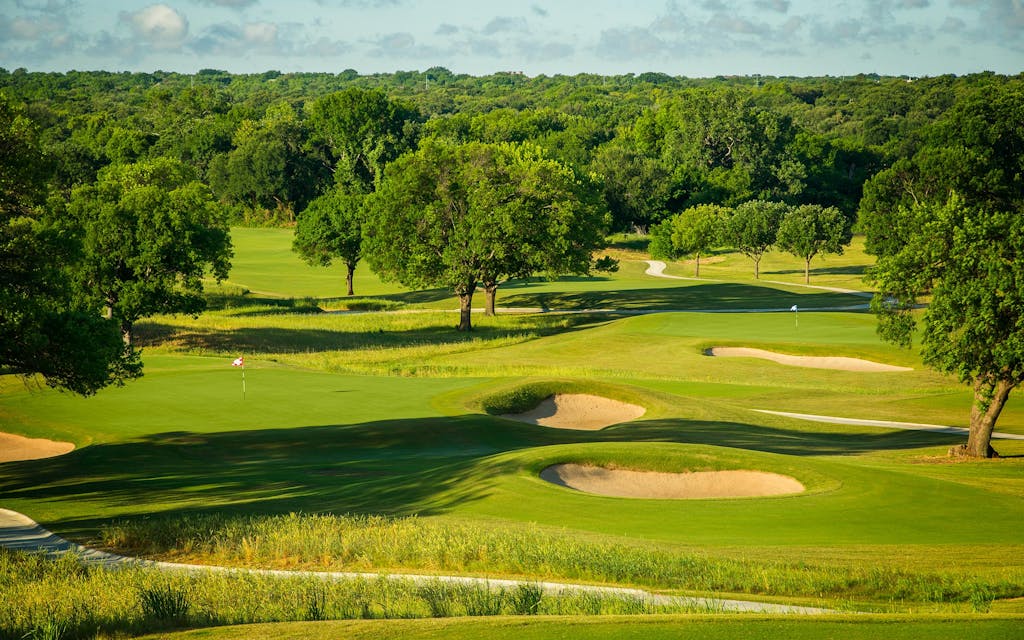
Rockwood Park
Fort Worth
John Bredemus, the mystical, Princeton-educated math teacher turned course architect who is credited with the creation of Fort Worth’s legendary Colonial Country Club, also fashioned eighteen holes along the West Fork of the Trinity River, back in 1938. That course, Rockwood, just five miles north of Colonial, served for decades as a decent municipal for those without the wherewithal to join a private club.
Then the City of Fort Worth paid Colligan Golf Design more than $5 million to revive Rockwood, starting in 2015. Better money was never spent. Rockwood reopened in 2017. Everything was new: tees, greens, fairways, bunkers, and drainage.
While the bones of the original Rockwood remain strong, the restoration sharpened subtle play angles, whittled interesting landforms into the broad fairways, and planted new bunkers in strategic locations, at the same time incorporating modern golf design elements such as improved irrigation, better agronomy, and finer sand.
The tee of the lovely, 142-yard par-3 eighth hole takes you to one of the highest points on the property. From there, you see downtown Fort Worth—and a massive green in the shape of an amorphous arrowhead, with a spacious false front just beyond a bunker that looks a lot closer to the green than it really is. The shortest hole at Rockwood, framed beautifully by its three balanced bunkers and two lone trees, is an ode to a time when length wasn’t all that mattered. (That said, here’s a pro tip: don’t leave it short.)
Just three miles northwest of downtown Fort Worth, Rockwood somehow manages to evoke the relative solitude of a course such as Starcke Park, in Seguin, or Squaw Valley, in Glen Rose. A handful of holes hug the bustling Jacksboro Highway, but the interior of the course recedes into low ground along the river, where the sounds of civilization fall away. Is Rockwood a course in a city? Or is it a course that rescues you from a city but returns you there in the end? It’s both. —Kevin Robbins
1851 Jacksboro Hwy; 817-392-6560; greens fees $23–$66; fortworthgolf.com

Texas Golf Glossary
Texas wedge: A shot played with a putter from off the green. Could also refer to the putter itself when used in that situation. The term is widely believed to have been coined sometime in the early twentieth century by Texas golfers who found an ingenious way to control the ball on hard, dry turf.
Grapevine
Grapevine
The late, great Byron Nelson, the Waxahachie-born golfer who became a professional phenom in the thirties and forties, influenced Grapevine’s design when it began life as an eighteen-hole course, in 1979. The now-27-hole property—the Irving-based design firm Golf Resources added the Bluebonnet nine to the existing Pecan and Mockingbird nines in 1999—sits alongside Grapevine Lake, giving the place an aura of intimacy and tranquility, most notably on the Pecan nine, where some holes play under and along the lake’s dam. Grapevine’s holes wander in every direction, and each is unique. A round here is a pleasant expedition, full of surprises and delights.
Grapevine represents, for the most part, a gentle test. That is not to say it’s easy. But it is, in the best sense, simple and sensible. Everything fits. Take the par-4 fifth hole on the Pecan nine: 405 yards from an elevated tee, moving right to left toward a vaguely reverse-redan green. It’s scenic, strategic, and, if you fancy, heroic. And, as on a handful of other holes on the Pecan and Mockingbird nines, both of which underwent renovations in the early aughts, you feel that you’re all alone with an allée of oaks. The affordability of the course is a bonus. —Kevin Robbins
3800 Fairway Dr; 817-410-3377; greens fees $22–$65; grapevinegc.com
Pecan Hollow
Plano
From the moment you step onto the property, it’s clear that Pecan Hollow is doing a whole lot right. The practice facilities are a significant part of the experience—a sizable range and a five-hole chip-and-putt course are lighted after dark, and you’re pretty much guaranteed to find a spot on the 14,000-square-foot practice green. Inside the clubhouse, a snack bar with a pleasing selection of food and beverages spills out into a couple of large seating areas, one of them a terrace overlooking the grounds. It’s a playground for the golf possessed.
But don’t forget why you came: the course is a delight. Strategic bunkering and tree placements keep you thinking and engaged, plus five sets of tees guarantee that anyone can enjoy the challenge. It’s long enough, 7,026 yards from the tips, that it often calls for a driver off the tee, but it will punish those who pull the big stick recklessly.
Most fun of all, though, are Pecan’s MiniVerde greens, which are big, sloped, and filled with nuance—and they’re quick. They roll true, so you’ll have only yourself to blame when (not if) you three-putt. But you’ll be left wanting to come back again and again to figure them out, and the affordable rates won’t stop you from doing so. —Shawn Shinneman
4501 Fourteenth; 972-941-7600; greens fees $35–$59; pecanhollowgc.com
This article appeared in the October 2023 issue of Texas Monthly with the headline “Swing Time.” A shorter, similar story originally published online on October 14, 2021. Subscribe today.
- More About:
- Sports
- Parks & Recs
- Golf
